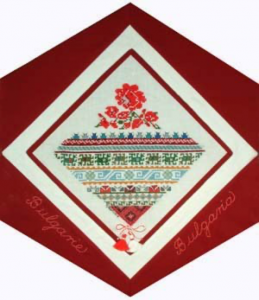Bulgaria

The Block
Marina Fedchenko created a sampler of intricately embroidered patterns found on traditional Bulgarian costumes for this block. Highlighting the three principal colours of Bulgarian embroidery of red, black and white, she has augmented the palette with often used greens, blues and gold. The richly-hewed design creates the illusion of a garden through the use of repetitive and layered rows of geometric and floral designs. The rose motif reflects the importance of this flower to Bulgaria, the world’s largest producer of attar of roses (rose oil), which is an essential component of most perfumes. At the bottom of the square is a hand-made martenista, a woven tassel of red and white thread. These tassels are given as gifts at the beginning of March, symbolizing the end of winter as well as marking the Bulgarian Independence Day. Bulgarians believe that carrying them will bring health, luck and fertility.
Cultural Profile
Bulgaria, in southeastern Europe, is home to the ‘Valley of Roses’ located at the foothill of the Balkan mountains. Roses, grown commercially in the country, are the national flower as well as a symbol of friendship presented by Bulgarians to visiting guests. The official language is Bulgarian and it is interesting to note that in Bulgaria, shaking the head from side to side means ‘yes,’ while nodding up and down means ‘no’. The Cyrillic script, used today by 252 million people, was developed in Bulgaria during the 9th century.
Bulgaria’s culture stems from the ancient Thracian, Slavic and Bulgar cultures, and some of the country’s most distinctive traditions date back many centuries. For example, the Kukeri, with their elaborate and impressive costumes designed to ward off evil spirits, dance around village squares and visit people’s houses to bring them good luck after the New Year. This merrymaking can be traced back to Thracian times, some two millennium ago.
Bulgarians are known for their intricately embroidered and elaborately decorated folk costumes. The colours, textiles and details used in each outfit signify the age, marital status and regional origin of its owner. The variations in traditional costumes are, therefore, staggering and provide a rich feast for the eyes. The richness and quality of embroidery done by Bulgarian women were already commented upon by travellers in the 16th century. Bulgarian embroiderers were known to use as many as 100 different stitches with predominant designs being the tree of life, flowers, horses or rooster heads.
The town of Chiprovtsi is well known for its rug making. The wool is produced and dyed locally by the men, while women weave the rugs on vertical looms. Almost all of the households in the town own a loom, and the knowledge of rug-making is passed down from grandmothers, to mothers and then daughters.
The architecture, music and dances also bear traces of their ancient roots and are known world-wide. The folk music of Bulgaria is so famous that it was sent into space with a team from NASA. The music, dances and choral singing, all performed in colourful costumes, feature the many regional variations yet, collectively, they represent the very heart and soul of Bulgarian culture. Koprivshtitza Festival, the première folk festival in the country, also features demonstrations of Old Bulgarian crafts.
Early Bulgarian newcomers, who came to Canada at the turn of the 20th century, were railway and road construction workers who helped create the infrastructure for Canada’s ground transportation system. Their hard work helped ensure the rapid development of Canada’s industrial life and economy.
Around 30,000 Bulgarians now live in Canada making them one of the nation’s smaller ethnic groups. Their hospitality and family oriented culture has led them to create a large number of associations, clubs and schools here, including the ‘Bulgarian-Canadian Society’ in Toronto, the ‘Association Socio-Culturelle Bulgare’ in Montreal and the ‘Bulgarian Home Society of British Columbia’ in Vancouver.
Sponsor: Bruce Burgess
